Key takeaways:
- Character development involves placing characters in challenging situations to reveal their flaws and growth.
- Well-developed characters enhance emotional connections and mirror readers’ personal struggles and triumphs.
- Techniques like detailed backstories, active voice, and authentic dialogue are crucial for effective character development.
- Characters serve as reflections of the writer’s experiences, teaching valuable lessons about forgiveness, resilience, and vulnerability.
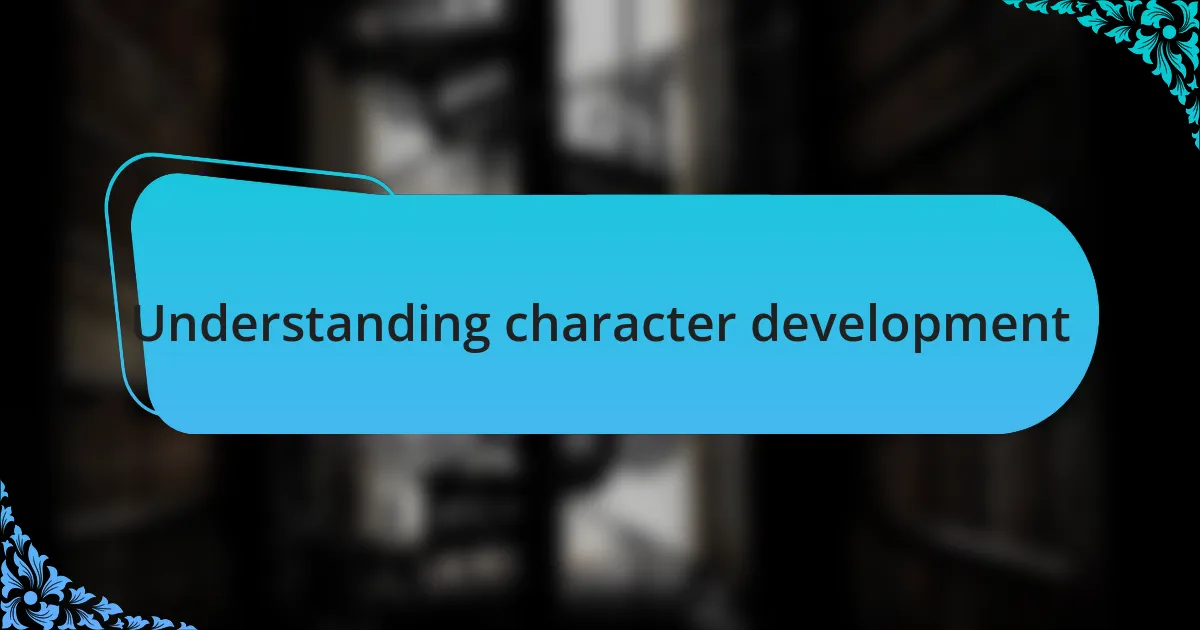
Understanding character development
Character development is a nuanced journey that goes beyond just outlining a character’s traits. For me, it’s about placing them in challenging situations that reveal their true selves. Have you ever found yourself unexpectedly drawn to a character who makes a terrible decision? That’s the magic of seeing them confront their flaws—it’s relatable and raw.
I think characters feel more alive when we see their internal struggles. For instance, I remember writing a character who wrestled with self-doubt; it was cathartic to explore those insecurities. Through this experience, I realized that allowing characters to grapple with their inner demons gives the audience a chance to reflect on their own battles. Don’t you find it’s in those moments of vulnerability that we connect most deeply with their stories?
Ultimately, character development is a constant dance between growth and obstacles. It’s fascinating to consider how each setback can be an opportunity for growth. I once crafted a character who faced failure repeatedly, yet with each stumble, they discovered new strengths. How do you feel when a character triumphs after overcoming their flaws? That’s the heart of storytelling—showing that even when we stumble, there’s always a path to growth.
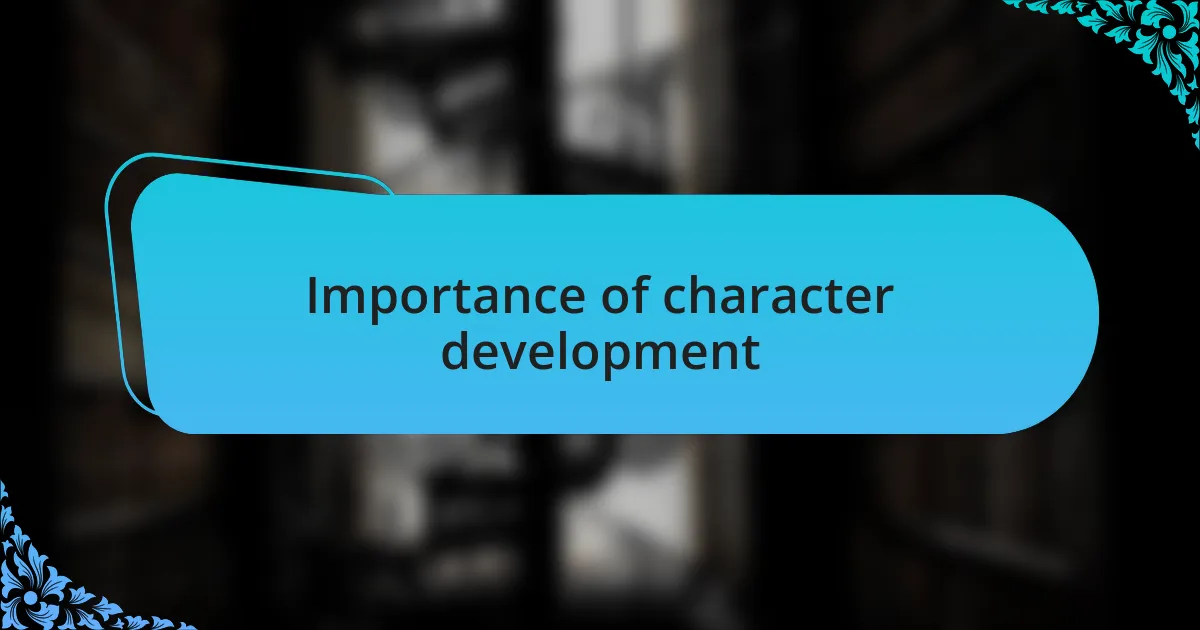
Importance of character development
Character development is crucial because it breathes life into a narrative. When I create a character, I want the audience to care about their journey. Think about it—have you ever felt invested in a story just because you wanted to see a character succeed? That emotional connection is often forged through well-crafted arcs that show growth, setbacks, and transformation.
I often find that well-developed characters enhance the themes of my stories. For instance, in a recent piece, I wrote about a character navigating grief. The way they processed their loss made the exploration of love and healing resonate deeply with readers. It’s a reminder that when characters evolve, they reflect our personal struggles and triumphs. Isn’t it fascinating how their journeys can mirror our own?
Moreover, the importance of character development lies in its ability to challenge societal norms and provoke thought. I vividly remember a character I wrote who defied stereotypes and faced judgment. Watching them confront biases not only made the story gripping but also sparked conversations among readers. Doesn’t it feel rewarding when literature encourages us to think critically about the world we live in?
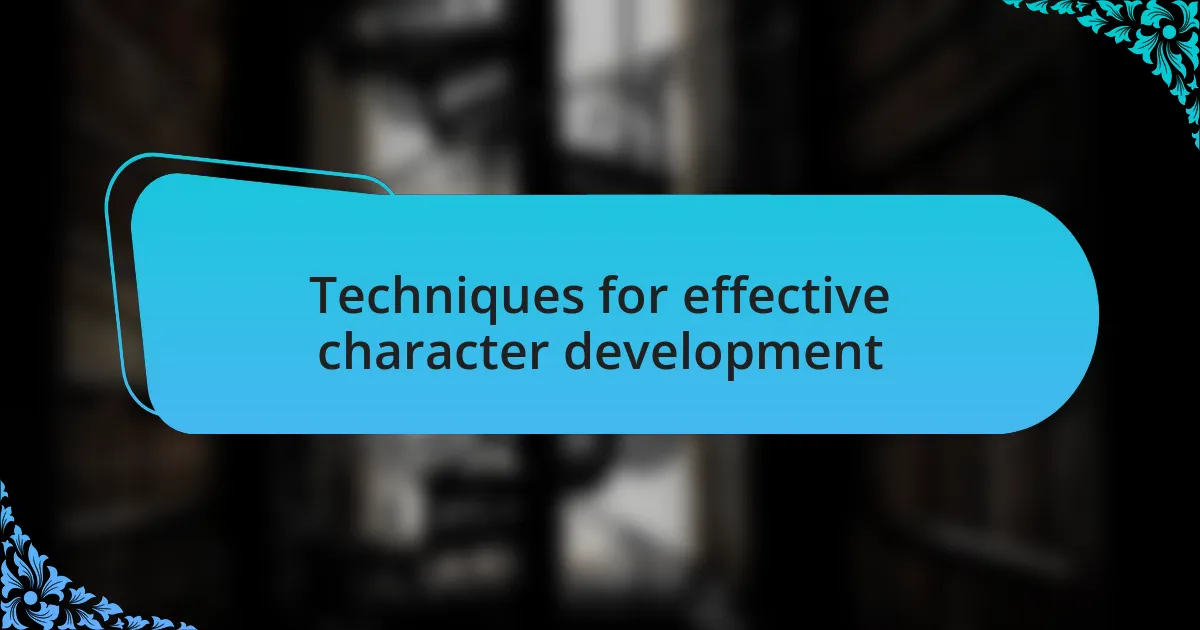
Techniques for effective character development
One technique that has worked wonders for me in character development is creating detailed backstories. I remember crafting a character who struggled with trust issues due to a difficult childhood. By fleshing out their past, I not only made their reactions more believable but also gave readers a reason to empathize with them. How often do we find ourselves connecting more with characters when we understand their history?
Another effective strategy I’ve employed is using active voice to show rather than tell. In a story where my character was chasing their dreams, I illustrated their determination through action—like their late-night writing sessions and the sacrifices they made. This approach allows readers to experience the journey rather than just read about it. Isn’t it intriguing how a character’s choices can engage us more profoundly than mere exposition?
Incorporating dialogue that reveals personality traits is another fantastic technique. I recall writing a scene where my character, frustrated and witty, had a quick exchange with a friend. Their banter not only showcased their dynamic but also peeled back the layers of their personality. Have you ever noticed how authentic dialogue can make a character leap off the page? It’s one of the most enjoyable aspects of writing for me.
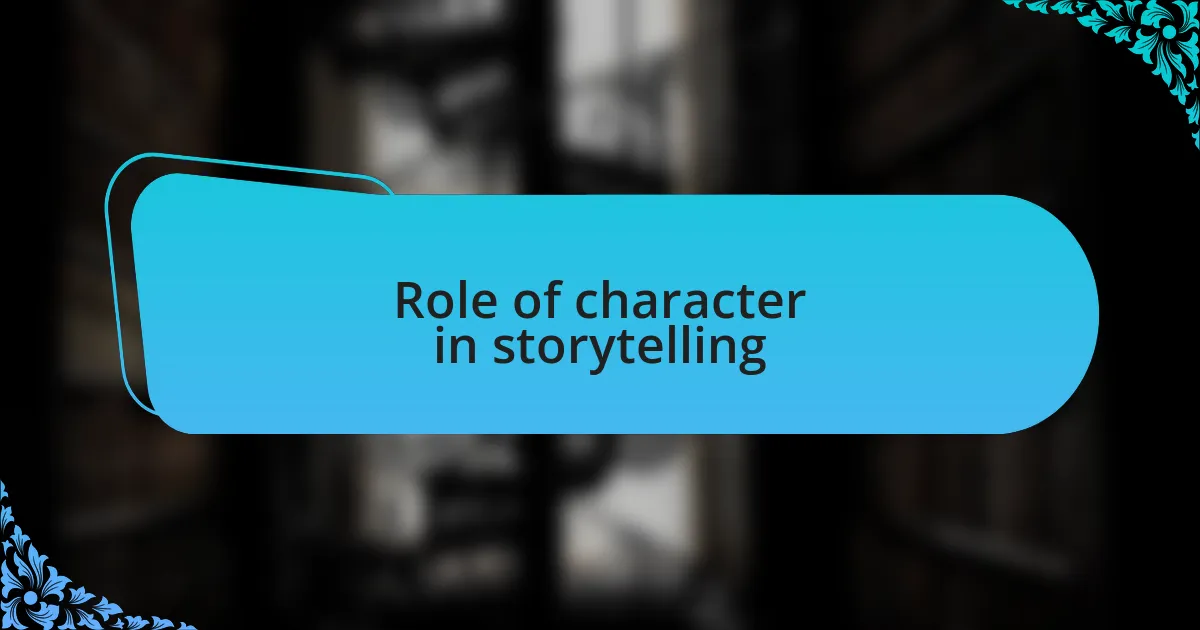
Role of character in storytelling
Characters are the heartbeat of any story; they drive the plot and evoke emotions. I often find myself wrapped up in their journeys, feeling their joys and heartbreaks as if they were my own. When a character faces a tough choice, how can a reader not be drawn into their world? Their dilemmas become our dilemmas, forging a deeper connection with the narrative.
I’ve experienced firsthand how well-developed characters can elevate a narrative. In one of my stories, a fiercely independent woman embarked on a quest that mirrored her internal struggles with vulnerability. Readers reached out to me, sharing how her journey resonated with their personal battles. Isn’t it remarkable how a character’s internal conflict can spark reflection in readers’ lives?
Moreover, the interactions between characters reveal their true selves and add richness to the storytelling. I once crafted a scene in which two characters, contrasting in their outlooks, engaged in a heated discussion. The tension not only highlighted their differences but also revealed their shared humanity. It made me wonder—how often do we reflect our own beliefs through the characters we create? Characters act as mirrors, reflecting both the light and shadows of our own experiences.
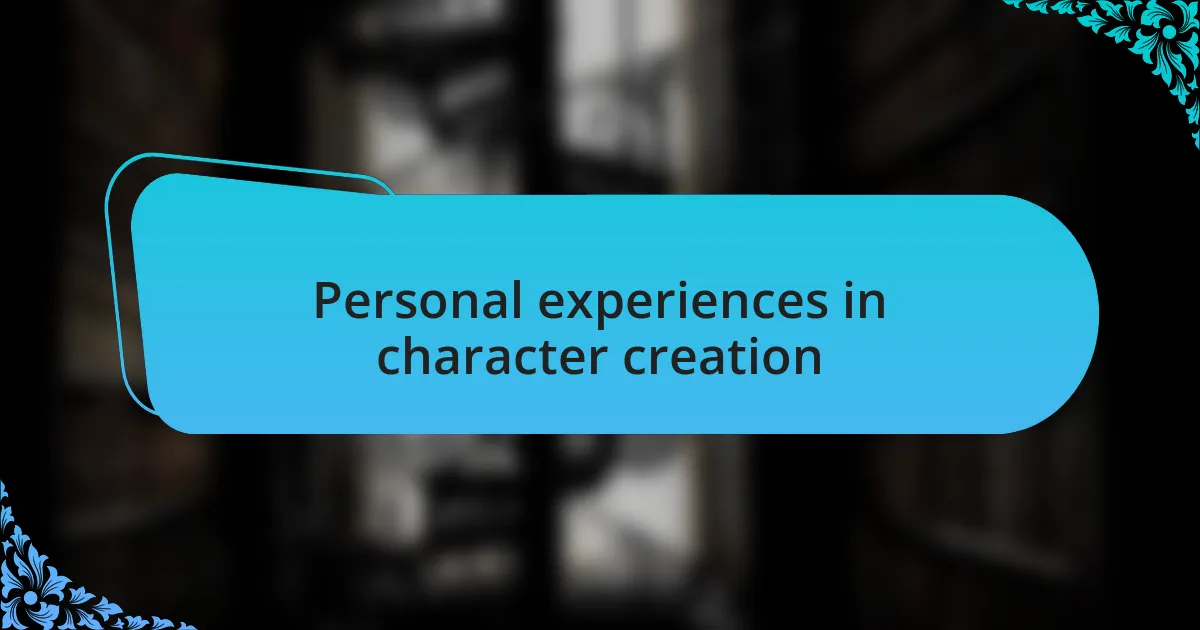
Personal experiences in character creation
When I create characters, I often draw from people I’ve encountered in real life—those quirks and stories linger with me. I remember a neighbor who had an insatiable curiosity about the world; she often inspired me to design a character whose inquisitiveness leads her on unexpected adventures. Isn’t it fascinating how a single trait can set the foundation for an entire narrative?
There have been moments in my writing journey when a character surprised me, taking a turn I didn’t anticipate. I crafted a timid artist who unexpectedly stood up for herself during a critical moment in the story. That twist wasn’t just a plot device; it reflected my own struggles with self-advocacy. It made me realize how characters can evolve in ways that mirror our own growth.
Sometimes, I find that characters evolve from personal experiences—an emotion I’ve felt or a decision I had to face. For example, in a recent story, I created a character grappling with isolation, much like how I felt during a particularly challenging time in my own life. Writing her journey to connection helped me process my emotions, and it made me wonder: how can the act of creating characters serve as a form of therapy for us writers?
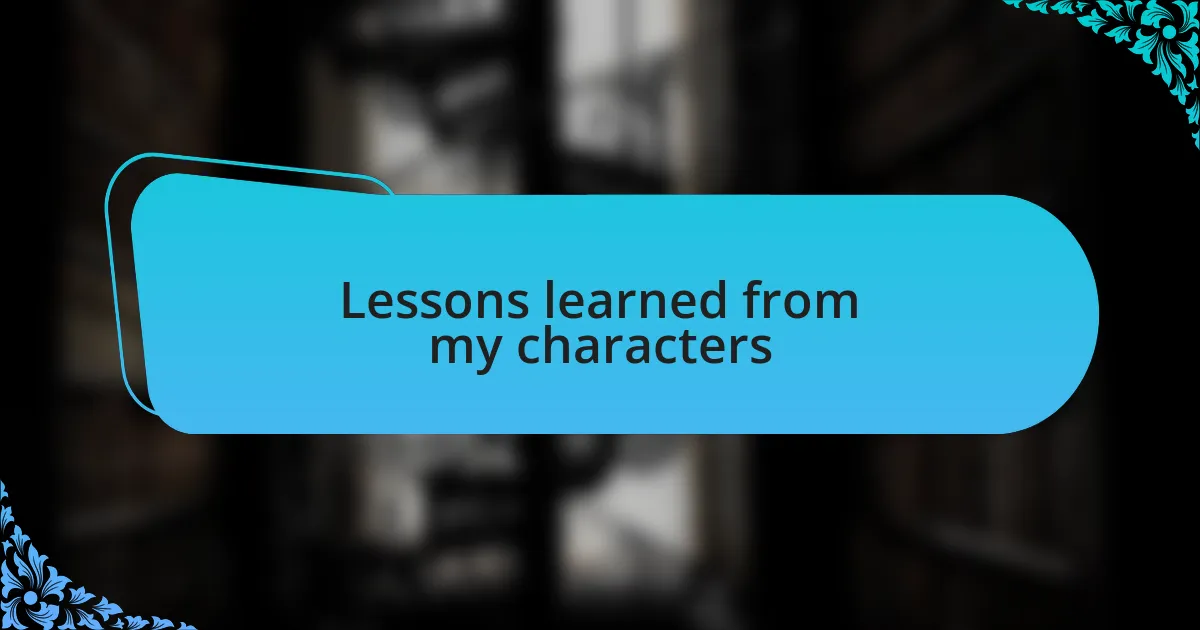
Lessons learned from my characters
Throughout my writing journey, I’ve learned that characters often teach me lessons I didn’t know I needed. I once created a character who struggled with forgiveness—a trait I, too, found challenging. As I explored her journey towards letting go of bitterness, I felt my own emotional barriers begin to soften, reminding me that growth often requires compassion, even in the face of personal hurt.
I also had a character whose resilience was born from a seemingly small setback that spiraled into significant growth. While writing about her struggles, I couldn’t help but reflect on my own moments of failure. Those experiences made me realize that sometimes, it’s not the grand triumphs but the small victories that shape who we are. Isn’t it interesting how fiction can mirror our reality so closely?
Sometimes, I find that dialogue with my characters can reveal deep truths about myself. For instance, I wrote a character who was fiercely independent yet secretly craved connection. While guiding her through her conflicts, I confronted my feelings of vulnerability and the fear of dependence. This exploration made me ponder: how often do we hide our true needs behind a facade of strength?